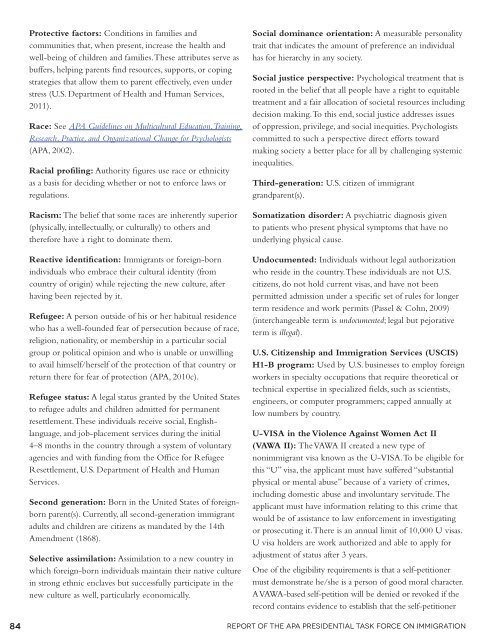Crossroads: The Psychology of Immigration in the New Century
Crossroads: The Psychology of Immigration in the New Century
Crossroads: The Psychology of Immigration in the New Century
You also want an ePaper? Increase the reach of your titles
YUMPU automatically turns print PDFs into web optimized ePapers that Google loves.
Protective factors: Conditions <strong>in</strong> families and<br />
communities that, when present, <strong>in</strong>crease <strong>the</strong> health and<br />
well-be<strong>in</strong>g <strong>of</strong> children and families. <strong>The</strong>se attributes serve as<br />
buffers, help<strong>in</strong>g parents f<strong>in</strong>d resources, supports, or cop<strong>in</strong>g<br />
strategies that allow <strong>the</strong>m to parent effectively, even under<br />
stress (U.S. Department <strong>of</strong> Health and Human Services,<br />
2011).<br />
Race: See APA Guidel<strong>in</strong>es on Multicultural Education, Tra<strong>in</strong><strong>in</strong>g,<br />
Research, Practice, and Organizational Change for Psychologists<br />
(APA, 2002).<br />
Racial pr<strong>of</strong>il<strong>in</strong>g: Authority figures use race or ethnicity<br />
as a basis for decid<strong>in</strong>g whe<strong>the</strong>r or not to enforce laws or<br />
regulations.<br />
Racism: <strong>The</strong> belief that some races are <strong>in</strong>herently superior<br />
(physically, <strong>in</strong>tellectually, or culturally) to o<strong>the</strong>rs and<br />
<strong>the</strong>refore have a right to dom<strong>in</strong>ate <strong>the</strong>m.<br />
Reactive identification: Immigrants or foreign-born<br />
<strong>in</strong>dividuals who embrace <strong>the</strong>ir cultural identity (from<br />
country <strong>of</strong> orig<strong>in</strong>) while reject<strong>in</strong>g <strong>the</strong> new culture, after<br />
hav<strong>in</strong>g been rejected by it.<br />
Refugee: A person outside <strong>of</strong> his or her habitual residence<br />
who has a well-founded fear <strong>of</strong> persecution because <strong>of</strong> race,<br />
religion, nationality, or membership <strong>in</strong> a particular social<br />
group or political op<strong>in</strong>ion and who is unable or unwill<strong>in</strong>g<br />
to avail himself/herself <strong>of</strong> <strong>the</strong> protection <strong>of</strong> that country or<br />
return <strong>the</strong>re for fear <strong>of</strong> protection (APA, 2010c).<br />
Refugee status: A legal status granted by <strong>the</strong> United States<br />
to refugee adults and children admitted for permanent<br />
resettlement. <strong>The</strong>se <strong>in</strong>dividuals receive social, Englishlanguage,<br />
and job-placement services dur<strong>in</strong>g <strong>the</strong> <strong>in</strong>itial<br />
4–8 months <strong>in</strong> <strong>the</strong> country through a system <strong>of</strong> voluntary<br />
agencies and with fund<strong>in</strong>g from <strong>the</strong> Office for Refugee<br />
Resettlement, U.S. Department <strong>of</strong> Health and Human<br />
Services.<br />
Second generation: Born <strong>in</strong> <strong>the</strong> United States <strong>of</strong> foreignborn<br />
parent(s). Currently, all second-generation immigrant<br />
adults and children are citizens as mandated by <strong>the</strong> 14th<br />
Amendment (1868).<br />
Selective assimilation: Assimilation to a new country <strong>in</strong><br />
which foreign-born <strong>in</strong>dividuals ma<strong>in</strong>ta<strong>in</strong> <strong>the</strong>ir native culture<br />
<strong>in</strong> strong ethnic enclaves but successfully participate <strong>in</strong> <strong>the</strong><br />
new culture as well, particularly economically.<br />
Social dom<strong>in</strong>ance orientation: A measurable personality<br />
trait that <strong>in</strong>dicates <strong>the</strong> amount <strong>of</strong> preference an <strong>in</strong>dividual<br />
has for hierarchy <strong>in</strong> any society.<br />
Social justice perspective: Psychological treatment that is<br />
rooted <strong>in</strong> <strong>the</strong> belief that all people have a right to equitable<br />
treatment and a fair allocation <strong>of</strong> societal resources <strong>in</strong>clud<strong>in</strong>g<br />
decision mak<strong>in</strong>g. To this end, social justice addresses issues<br />
<strong>of</strong> oppression, privilege, and social <strong>in</strong>equities. Psychologists<br />
committed to such a perspective direct efforts toward<br />
mak<strong>in</strong>g society a better place for all by challeng<strong>in</strong>g systemic<br />
<strong>in</strong>equalities.<br />
Third-generation: U.S. citizen <strong>of</strong> immigrant<br />
grandparent(s).<br />
Somatization disorder: A psychiatric diagnosis given<br />
to patients who present physical symptoms that have no<br />
underly<strong>in</strong>g physical cause.<br />
Undocumented: Individuals without legal authorization<br />
who reside <strong>in</strong> <strong>the</strong> country. <strong>The</strong>se <strong>in</strong>dividuals are not U.S.<br />
citizens, do not hold current visas, and have not been<br />
permitted admission under a specific set <strong>of</strong> rules for longer<br />
term residence and work permits (Passel & Cohn, 2009)<br />
(<strong>in</strong>terchangeable term is undocumented; legal but pejorative<br />
term is illegal).<br />
U.S. Citizenship and <strong>Immigration</strong> Services (USCIS)<br />
H1-b program: Used by U.S. bus<strong>in</strong>esses to employ foreign<br />
workers <strong>in</strong> specialty occupations that require <strong>the</strong>oretical or<br />
technical expertise <strong>in</strong> specialized fields, such as scientists,<br />
eng<strong>in</strong>eers, or computer programmers; capped annually at<br />
low numbers by country.<br />
U-VISA <strong>in</strong> <strong>the</strong> Violence Aga<strong>in</strong>st Women Act II<br />
(VAWA II): <strong>The</strong> VAWA II created a new type <strong>of</strong><br />
nonimmigrant visa known as <strong>the</strong> U-VISA. To be eligible for<br />
this “U” visa, <strong>the</strong> applicant must have suffered “substantial<br />
physical or mental abuse” because <strong>of</strong> a variety <strong>of</strong> crimes,<br />
<strong>in</strong>clud<strong>in</strong>g domestic abuse and <strong>in</strong>voluntary servitude. <strong>The</strong><br />
applicant must have <strong>in</strong>formation relat<strong>in</strong>g to this crime that<br />
would be <strong>of</strong> assistance to law enforcement <strong>in</strong> <strong>in</strong>vestigat<strong>in</strong>g<br />
or prosecut<strong>in</strong>g it. <strong>The</strong>re is an annual limit <strong>of</strong> 10,000 U visas.<br />
U visa holders are work authorized and able to apply for<br />
adjustment <strong>of</strong> status after 3 years.<br />
One <strong>of</strong> <strong>the</strong> eligibility requirements is that a self-petitioner<br />
must demonstrate he/she is a person <strong>of</strong> good moral character.<br />
A VAWA-based self-petition will be denied or revoked if <strong>the</strong><br />
record conta<strong>in</strong>s evidence to establish that <strong>the</strong> self-petitioner<br />
84 Report <strong>of</strong> <strong>the</strong> APA Presidential Task Force on <strong>Immigration</strong>
















